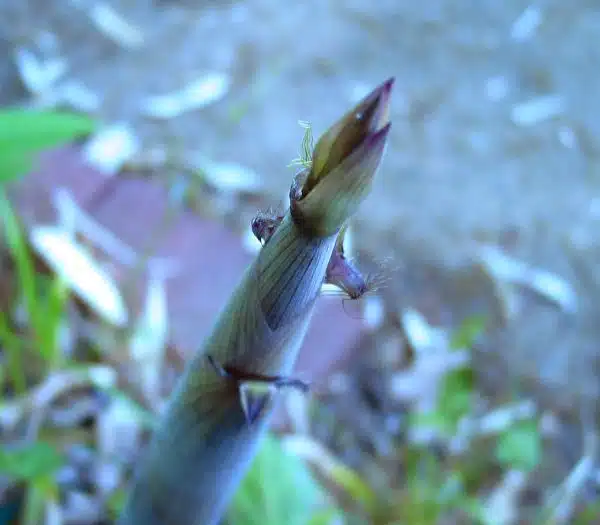As a bamboo horticulturalist, it is essential to understand the best conditions for cultivating healthy and thriving bamboo plants. Bamboo is a fast-growing, versatile plant that has gained popularity in recent years due to its numerous uses, including construction, furniture making, and food production. However, to achieve optimal growth and yield of bamboo, certain environmental conditions must be met.
Bamboo is native to various regions worldwide and grows best in areas with warm climates and high humidity levels. The plant requires rich soil with high organic matter content to support its rapid growth rate. Proper irrigation is crucial as the plant needs adequate water during the growing season but cannot tolerate standing water or wet feet. Understanding these factors and their influence on growing bamboo can help horticulturalists provide the best environment for the plant’s growth, ensuring maximum yields and quality products for those who rely on them.
The Natural Habitat Of Bamboo
Bamboo is a highly versatile plant that thrives in many different natural habitats. From the tropical rainforests of Southeast Asia to the cool, mountainous regions of China and Japan, bamboo can be found in a wide range of environments. Despite this diversity, there are some common characteristics that define the natural habitat of bamboo.
One of the most important factors for growing bamboo is adequate sunlight. Most species require full sun or partial shade to thrive, although some can tolerate more shade than others. In addition to light, bamboo also requires well-draining soil that is rich in organic matter. It is important to note that bamboo does not tolerate waterlogged soil or standing water, as this can lead to root rot and other problems.
Another key factor in the natural habitat of bamboo is temperature. While it varies depending on the species, most types of bamboo prefer warm temperatures between 60 and 90 degrees Fahrenheit. However, some varieties can withstand freezing temperatures and even snow, making them suitable for colder climates. Ultimately, understanding these natural growing conditions will help you create an environment where your bamboo can thrive and prosper.
Given these factors, it’s clear that growing healthy bamboo requires careful attention to its natural habitat and environmental conditions. In the following sections, we’ll take a closer look at the specific climate requirements necessary for optimal growth – including temperature ranges, rainfall levels, and more – so you can ensure your bamboo has everything it needs to flourish.
Climate Requirements For Optimal Growth
Bamboo is a versatile and hardy plant that can be grown in a variety of climates, but there are certain conditions that are necessary for optimal growth. The ideal climate for bamboo cultivation is one with warm temperatures and high humidity. Bamboo grows best in regions with an average annual temperature of 20-30°C and an average annual rainfall of 1000-2000mm. However, it can also thrive in areas with cooler temperatures as long as the soil is rich and moist.
Bamboo farming faces several challenges related to climate, including drought, flooding, and extreme temperatures. Drought can cause stress to the plant, leading to stunted growth or even death. Flooding can also be devastating to bamboo crops because it can wash away the topsoil and expose the roots to oxygen deprivation. Extreme temperatures can damage or kill bamboo plants, particularly if they experience prolonged exposure to freezing temperatures.
To overcome these challenges, bamboo cultivation techniques have been developed over time to ensure optimal growth conditions for the plant. These include irrigation systems to provide consistent moisture levels, soil amendments to improve soil structure and fertility, and shade structures to protect against excessive sunlight exposure. With proper care and attention, bamboo can be cultivated successfully in a wide range of environments.
In order to achieve optimal growth conditions for bamboo plants, it is essential to consider all aspects of their environment. One critical factor is the amount of sunlight that they receive each day. Sunlight plays a crucial role in photosynthesis – the process by which plants convert sunlight into energy – so it’s important that bamboo receives enough light throughout the day. In our next section, we will discuss how sunlight affects bamboo growth and how farmers can ensure that their crops receive adequate amounts of light each day.
The Importance Of Sunlight
Bamboo plants require full sun to grow optimally, making adequate amounts of direct sunlight essential for successful cultivation. Duration of sunlight is also important, as bamboo plants require at least six hours of full sun or eight hours of partial sun per day. Too much sunlight, however, can be detrimental to the health of the plant, so it is important to find a balance between sufficient amounts and too much exposure. In order to create the best conditions for growing bamboo, it is important to consider the amount and duration of sunlight.
Amount Of Sunlight
Sunlight intensity is crucial for the growth of bamboo plants. As a horticulturalist, it is essential to understand that different species of bamboo have varying sunlight needs. Some types require full sun exposure, while others prefer partial shade. However, regardless of the type, all bamboo plants need an optimal amount of sunlight to thrive.
The optimal exposure time for bamboo plants depends on the species and location. Ideally, bamboo requires at least 6 hours of direct sunlight per day. However, in hotter areas, partial shade during midday can prevent sunscald and leaf burn. It is essential to monitor the amount and intensity of sunlight received by your plants regularly. This will help you identify any changes in their growth patterns, allowing you to adjust their exposure accordingly.
In conclusion, understanding the importance of sunlight for bamboo growth is vital. Sunlight affects plant photosynthesis and energy production processes, which are essential for healthy plant growth. As a horticulturalist or gardener looking to grow bamboo successfully, it is critical to provide adequate light conditions that meet your plant’s requirements for optimal growth. By ensuring proper sunlight intensity and exposure time, you can enjoy a lush and healthy bamboo garden or landscape that will serve as an excellent source of inspiration and relaxation for years to come.
Duration Of Sunlight
As a bamboo horticulturalist, it is crucial to have an in-depth understanding of the impact of sunlight duration on plant growth. The duration of sunlight has a direct effect on the optimal photosynthesis conditions required for healthy bamboo growth. It is essential to note that different species of bamboo require varying amounts of sunlight exposure. Therefore, it is vital to consider the duration and intensity of light received by your plants regularly.
The optimal duration of sunlight for bamboo plants depends on various factors such as species, location, and weather conditions. As a general rule, most bamboo plants require at least six hours of direct sunlight per day to thrive. However, in hotter regions, partial shade during midday may be necessary to prevent sunscald and leaf burn. It is vital to monitor your plant’s growth patterns regularly to identify any changes that may indicate inadequate light conditions.
In conclusion, the duration of sunlight plays a critical role in determining the optimal photosynthesis conditions for bamboo growth. As a horticulturalist or gardener looking to grow healthy and vibrant bamboo plants, it is essential to provide adequate exposure time that meets each plant’s specific requirements. By monitoring the amount and intensity of light received by your plants regularly, you can make any necessary adjustments that will ensure optimal growth and health for your beautiful Bamboo garden or landscape.
Soil Requirements For Healthy Bamboo Growth
The soil is the foundation of any plant’s growth, and bamboo is no different. It requires optimal conditions to thrive and reach its full potential. The right soil conditions can make all the difference in the world when it comes to growing healthy, robust bamboo plants.
To create the ideal environment for bamboo growth, you need to start with improving fertility. Bamboo requires rich, fertile soil that is nutrient-dense and well-draining. Adding organic matter like compost or manure can help increase soil fertility and provide a steady supply of nutrients for your bamboo plants.
Testing acidity is also crucial in ensuring healthy growth of bamboo. The ideal pH range for most species of bamboo falls between 5.5 and 6.5, which is slightly acidic. You can test your soil’s acidity levels using a simple home testing kit or by taking a sample of your soil to a local agricultural extension office.
In conclusion, when it comes to growing healthy bamboo plants, having the right soil conditions is essential. Improving fertility by adding organic matter like compost or manure can help ensure nutrient-rich soil while testing acidity levels will ensure that the pH range is optimal for your chosen species of bamboo to grow strong and healthy. In the subsequent section, we will delve deeper into nutrient and pH levels required for optimal bamboo growth without missing a step.
Nutrient And Ph Levels
Nutrient deficiency and pH balance are two critical factors that can have a significant impact on the growth and health of bamboo. Although bamboo is known to be a hardy plant, it requires specific soil conditions to thrive. Nutrient-deficient soil can lead to stunted growth, yellowing leaves, and even death of the plant. Similarly, an imbalanced pH level can affect nutrient absorption and uptake in plants. Therefore, it is crucial to maintain proper nutrient levels and pH balance in soil for optimal bamboo growth.
Fertilizer application is one way to improve nutrient levels in soil for the healthy growth of bamboo. Adding organic fertilizers such as compost or manure improves soil quality by providing essential nutrients like nitrogen, phosphorus, and potassium. It is important to apply fertilizer at the right time and in the correct amount as excess fertilizer application can lead to toxicity in plants. Soil testing before fertilizer application helps determine which nutrients are lacking in the soil so that the appropriate fertilizer can be used.
Soil testing is also necessary to ensure proper pH balance for healthy bamboo growth. The ideal pH range for most species of bamboo is between 6.0 and 7.5. If the pH level is too high or too low, plants may not be able to absorb certain nutrients leading to deficiencies or toxicities that affect their overall health or development. By regularly testing soil PH levels, gardeners can adjust their soils’ acidity or alkalinity levels accordingly by adding materials such as limestone or sulfur-based products.
Improving nutrient levels and maintaining proper pH balance in soil are essential for growing healthy bamboo plants. Fertilizer application and regular soil testing are necessary practices for ensuring optimal bamboo growth conditions. In addition to these measures, watering needs also play a crucial role in promoting healthy bamboo development which we will discuss further in the subsequent section about ‘watering needs.’
Watering Needs
When it comes to growing bamboo, providing adequate water is crucial for its growth and development. Watering frequency depends on the climate and the soil moisture levels. In general, bamboo requires a consistent supply of water throughout the growing season.
The frequency of watering will depend on several factors, including the type of bamboo, soil type, and weather conditions. As a general rule, bamboo should be watered deeply once a week during dry periods. It is important to note that overwatering can be just as detrimental to bamboo as underwatering. To prevent overwatering, it is recommended to check the soil moisture levels before watering.
Maintaining proper soil moisture levels is essential for healthy bamboo growth. Bamboo prefers slightly acidic soils with good drainage. The ideal soil pH level for bamboo is between 5.5 and 6.5. One way to maintain proper soil moisture levels is by incorporating organic matter into the soil, which helps improve drainage and water retention.
When it comes to growing healthy bamboo, understanding its watering needs is crucial. By providing consistent watering at appropriate intervals and maintaining proper soil moisture levels, you can ensure optimal growth and development of your bamboo plant. In the next section, we will explore the role of drainage in promoting healthy bamboo growth.
The Role Of Drainage
Watering is essential to the growth of bamboo, but it’s not enough to ensure healthy plants. The role of drainage is also critical in creating the best conditions for growing bamboo. Poor drainage can lead to waterlogged soil, which can suffocate roots and promote fungal growth. Therefore, it’s crucial to understand the importance of proper drainage when growing bamboo.
Mulching is an effective way to improve drainage in bamboo cultivation. By covering soil with organic matter such as wood chips or leaves, mulch helps to retain moisture while allowing excess water to drain away from the roots. This creates a well-aerated soil that promotes root growth and prevents waterlogging. Mulching also helps regulate soil temperature and suppress weed growth, further enhancing the overall health of your bamboo plants.
On the other hand, poor drainage can have devastating effects on bamboo growth. Waterlogged soil can lead to root rot and other fungal diseases that can kill plants or stunt their growth. In addition, standing water attracts pests like mosquitoes and promotes weed growth, making it more difficult to maintain healthy plants. Therefore, it’s important to monitor your soil’s drainage capabilities and take steps such as adding mulch or adjusting planting location if necessary.
To achieve optimal results in growing bamboo, it’s necessary to choose the right species that will thrive in your climate and environmental conditions. Different species have different requirements for sunlight exposure, temperature range, soil type and pH levels etc., so careful consideration must be given before selecting a variety for cultivation. The next section will explore how you can select appropriate species based on these factors.
Choosing The Right Bamboo Species
Bamboo species selection depends on a variety of factors, from climate to soil and sunlight to water. Understanding the specific needs of each species is essential to successful bamboo growth. For instance, soil should be well-drained and nutrient-rich, and containers should be deep and wide enough to accommodate root growth. Pruning and fertilizing should be done regularly to ensure a healthy and vigorous plant. Growth rate is also an important factor; some species grow up to a foot per day while others may take months to reach their full size. A high-quality potting mix and mulch are also important for bamboo health, as is pollination and propagation. Lastly, be mindful of potential pests and diseases that can damage or destroy bamboo.
Climate
Bamboo cultivation is a popular activity for garden enthusiasts and farmers alike. One of the most crucial factors to consider when choosing the right bamboo species is the climate in which it will be grown. Bamboo thrives in areas with tropical or subtropical climates, where temperatures range from 10 to 35 degrees Celsius. In these regions, bamboo can grow up to three feet per day.
Moisture management is also essential for growing healthy bamboo plants. Bamboo requires an adequate amount of water, but it should not be overwatered as this can lead to root rot and other issues. The ideal condition for growing bamboo is a well-draining soil that retains moisture but does not become saturated. It is best to maintain consistent moisture levels by watering regularly, especially during periods of drought.
In conclusion, when selecting a bamboo species for cultivation, it is important to consider the climate and moisture conditions of your area carefully. Tropical or subtropical climates are ideal for growing bamboo, while proper moisture management ensures healthy growth and prevents disease. By taking these factors into account, you can choose the right bamboo species that will thrive in your environment and provide long-lasting beauty and benefits.
Soil
The soil in which bamboo is planted plays a crucial role in its growth and survival. Bamboo requires well-draining soil that is rich in organic matter and nutrients. Different bamboo species have different soil preferences, so it is essential to choose the right type of soil for the specific species you want to grow.
There are two primary types of bamboo soil: clay loam and sandy loam. Clay loam soils are ideal for growing running bamboo, while sandy loam soils are better suited for clumping bamboo. Before planting your bamboo, it is important to prepare the soil properly by removing any weeds or debris, loosening the soil, and adding compost or other organic matter.
Proper maintenance of the soil is also necessary for healthy bamboo growth. Fertilizer can be applied regularly throughout the growing season to ensure that the plants receive adequate nutrients. Additionally, mulch can be added around the plant base to help retain moisture and prevent weed growth. With proper soil preparation and maintenance, your chosen bamboo species will thrive and provide long-lasting beauty and benefits.
Sunlight
Choosing the right bamboo species for your garden involves considering several factors. One of these factors is sunlight, which plays a vital role in the growth and development of bamboo. Different types of bamboo have varying requirements for light, so it is essential to choose a species that will thrive in your specific growing conditions.
Clumping bamboos generally require more shade than running bamboos. These types of bamboos are often smaller and more delicate, with thinner leaves that cannot tolerate direct sunlight for extended periods. Running bamboos, on the other hand, can handle more sun exposure and are typically larger and hardier. However, some running bamboos may still require partial shade during the hottest parts of the day.
In addition to choosing the right type of bamboo based on its sunlight requirements, it is also important to consider pruning techniques. Regular pruning helps maintain healthy growth and prevents overcrowding, which can lead to disease or pest infestations. Clumping bamboo requires less pruning than running bamboo because it tends to grow more slowly and in compact clusters. Running bamboo, however, requires more aggressive pruning to keep its growth in check and prevent it from spreading too quickly. By taking into account these factors when selecting your bamboo species, you can ensure that your plants will thrive and provide beauty and benefits for years to come.
Propagation Techniques
Bamboo is a versatile and fast-growing plant that can thrive in various environmental conditions. However, for optimal growth, it requires specific planting techniques. Propagation techniques are essential to ensure the successful establishment of bamboo plants.
Planting depth is an important consideration when planting bamboo. Generally, bamboo should be planted at a depth of 2-3 inches below the soil surface. This depth allows the plant’s roots to establish themselves firmly in the ground without being too deep or too shallow. Planting too deep may result in stunted growth or even death, while planting too shallow can lead to root exposure and dehydration.
Cutting preparation is also crucial when propagating bamboo. A healthy cutting with at least two nodes should be selected from a mature plant during dormancy. The cutting should then be trimmed to remove any leaves and branches, leaving only a few leaves at the top intact. The cutting should then be allowed to dry for several days before being planted in well-draining soil.
• When selecting a site for planting bamboo, consider factors such as sunlight exposure and soil moisture levels. • Bamboo plants require regular watering during their first year of growth. • Apply fertilizer every six months during the growing season to promote healthy growth.
As with any horticultural practice, proper propagation techniques are vital for successful plant growth. Following these planting tips will ensure that your bamboo plants thrive in their new environment. In the next section, we will explore transplanting tips that will help you maintain healthy and robust bamboo plants.
Transplanting Tips
Propagation techniques are essential for growing healthy bamboo plants. However, the right conditions are crucial for the plant’s growth and development. Bamboo thrives in warm, tropical or subtropical climates with high humidity levels. Although it is a versatile plant that can adapt to various soil types, it prefers well-drained soil with slightly acidic to neutral pH levels.
To ensure optimal growth conditions, it is vital to consider factors such as sunlight, water, and nutrients. Bamboo requires plenty of sunlight to photosynthesize, but too much direct sunlight can cause leaf scorching. Therefore, partial shade is ideal for bamboo plants. Water management is critical for successful bamboo cultivation. The plant needs consistent moisture but not waterlogged soil. Overwatering can lead to root rot and other fungal diseases.
Transplanting challenges and root system management are significant aspects of bamboo cultivation. Transplanting should be done during the early stages of growth when the roots have not spread widely into the soil. This process involves uprooting the young plant from its current container or location and replanting it elsewhere. Root system management is essential for preventing invasive growth patterns and maintaining healthy plant development.
| Growth Factors | Optimal Levels |
|---|---|
| Sunlight | Partial Shade |
| Water | Consistent Moisture |
| Soil pH | Slightly Acidic to Neutral |
In summary, growing healthy bamboo requires proper care and maintenance techniques such as propagation methods, transplanting techniques, and root system management practices. While there may be some challenges along the way, including managing invasive growth patterns and preventing root rot disease through proper watering methods can help ensure your bamboo plants thrive in any environment. In the next section on maintenance and care tips for your bamboo plants, we will delve deeper into these cultivation strategies to help you grow robust and healthy bamboo plants all year round!
Maintenance And Care
- Bamboo plants require regular fertilization to ensure healthy growth and development.
- Watering bamboo plants should take place frequently and evenly, with the soil kept moist throughout the growing season.
- Pruning should be done in order to maintain the desired shape and size of the bamboo plant, as well as to encourage new shoots.
- Fertilizers should be selected based on the variety of bamboo planted, as different species require different nutrient concentrations.
- Careful watering practices should be observed in order to ensure that the plant is receiving the necessary water without becoming waterlogged or having its roots too dry.
- Pruning should be conducted after the growing season, in order to limit any damage to the bamboo shoots.
Fertilization
As a bamboo horticulturalist, I have discovered that fertilization plays a crucial role in the maintenance and care of bamboo plantations. One of the significant factors to consider when it comes to fertilization is choosing between organic and synthetic fertilizers. Organic fertilizers are derived from natural sources and contain essential nutrients required for the growth of bamboo, such as nitrogen, phosphorus, and potassium. On the other hand, synthetic fertilizers are composed of chemically engineered substances that provide quick results but may result in long-term damage to the soil.
The timing of fertilization is also an important aspect that affects the growth rate and health of bamboo plants. It is recommended to apply fertilizer during the growing season, which typically starts in early spring and continues till fall. During this period, bamboo plants require more nutrients to support their growth and development. However, excessive application of fertilizer can lead to over-fertilization and cause harm to the plant’s roots by burning them.
In conclusion, proper fertilization is crucial for growing healthy bamboo plants. Choosing between organic or synthetic fertilizers depends on personal preference and environmental considerations. Timing also plays a significant role in ensuring that fertilizer application is done at appropriate intervals without causing any damage to the plant’s roots. By following these guidelines on fertilization, one can ensure optimal growth conditions for their bamboo plantation.
Watering
Proper watering is another essential factor in maintaining healthy bamboo plantations. Watering frequency depends on various factors, such as soil type, location, and climate. In general, bamboo plants require regular watering during the growing season to ensure optimal growth conditions. However, excessive watering can lead to waterlogging and cause damage to the roots.
Irrigation methods also play a crucial role in ensuring that bamboo plants receive the right amount of water. Drip irrigation is one of the most effective methods for providing adequate moisture without overwatering. This method delivers water directly to the roots, reducing water loss through evaporation and runoff. Additionally, mulching around the base of bamboo plants can help retain moisture in the soil.
In summary, proper watering is vital for maintaining healthy bamboo plantations. It is essential to consider factors such as watering frequency and irrigation methods when developing a watering schedule. By providing adequate moisture through drip irrigation and mulching while avoiding overwatering, one can ensure optimal growth conditions for their bamboo plantation.
Pruning
As a bamboo horticulturalist, maintaining healthy bamboo plantations is of utmost importance. One aspect of this maintenance and care is pruning. Pruning techniques are essential for controlling the growth patterns of bamboo plants, preventing overcrowding, and promoting optimal growth conditions.
Pruning involves removing unwanted or dead culms (stems) to encourage new growth and maintain the plant’s health. The ideal time for pruning is in late winter or early spring when the plant is dormant. It is important to use sharp and sterile tools to avoid damaging the remaining culms and introducing diseases into the plant.
Different pruning techniques can be used depending on the desired outcome. For example, thinning out culms allows more light to reach the lower parts of the plant, promoting new growth. On the other hand, cutting back older culms stimulates new shoots from the base of younger culms. Proper pruning techniques help maintain an attractive appearance while ensuring optimal growth conditions for a healthy bamboo plantation.
Pest And Disease Management Strategies
Integrated pest and disease management strategies are essential to maintain healthy bamboo groves. Prevention is the key to avoid the use of harmful fungicides and pesticides that can be detrimental to the environment. Regular monitoring of the plantation, cleaning up fallen debris, and maintaining proper irrigation practices can help prevent infestations. For example, aphids can be controlled by releasing ladybugs that feed on them naturally.
Natural control measures are highly recommended to manage pests and diseases. Introducing beneficial insects, such as praying mantis and lacewings, can help eliminate pests without harming the bamboo or surrounding ecosystem. Additionally, planting disease-resistant bamboo varieties can reduce the need for treatments.
While natural control measures are preferable, sometimes it is necessary to use fungicides and pesticides when infestations become severe. In such cases, it is important to follow recommended guidelines for their safe application. It is equally important to choose products that have minimal environmental impact.
In order to ensure a healthy harvest, it is essential to implement effective pest and disease management strategies in your bamboo grove. By choosing natural control measures whenever possible and using fungicides/pesticides with care when necessary, you’ll be able to produce beautiful and healthy crops of bamboo year after year. In the next section, we will delve into harvesting techniques that will maximize your yield while ensuring sustainable growth practices.
Harvesting Techniques
- Fertilizing bamboo is essential for optimal growth; it should be done after fresh shoots appear and should be repeated every 6-8 weeks.
- Watering bamboo must be done regularly to ensure successful growth. In general, it should be watered deeply every other day in the summer and every 3-4 days in the winter.
- Pruning should be done at least once a year to help maintain the shape and size of the bamboo.
- Dead or damaged culms can be removed to improve air circulation, allowing the roots to take in more oxygen and nutrients.
- Pruning can also be done to promote new growth and to remove branches that are blocking light from other areas of the bamboo.
- It is important to remember that bamboo should not be pruned too drastically, as this may harm the plant and reduce its health.
Fertilizing
As a bamboo horticulturalist, one of the most crucial aspects of growing healthy bamboo is fertilization. There are two types of fertilizers available for bamboo growth – organic and chemical. Organic fertilizers, such as compost or manure, release nutrients slowly and provide long-lasting benefits to the soil. Chemical fertilizers, on the other hand, offer quick results but may have harmful effects on the environment if not used correctly.
Timing of fertilization is also an important consideration when growing bamboo. The best time to apply fertilizer is during the active growing season, which typically occurs in spring and summer. Applying fertilizer too early or too late could disrupt the plant’s natural growth cycle and affect its overall health. It’s also essential to apply fertilizer evenly across the planting area to ensure all bamboo plants receive adequate nutrients.
In conclusion, selecting the appropriate type of fertilizer and applying it at the right time is essential for optimal bamboo growth. Organic fertilizers can provide long-lasting benefits with minimal environmental impact while chemical fertilizers offer quick results but require careful application to avoid harm to surrounding ecosystems. Timing is key when it comes to fertilizing bamboo; applying it during the active growing season will help ensure healthy and robust plants.
Watering
Watering is another crucial aspect to consider when it comes to harvesting bamboo. The frequency and amount of watering are critical factors in ensuring healthy and robust plants. It’s essential to avoid overwatering as it can lead to root rot, while underwatering can cause the plant’s leaves to wilt and turn yellow.
The best watering technique for bamboo is deep watering, which involves thoroughly saturating the soil around the plant’s roots. This technique helps promote deep root growth, making the plant more resistant to drought and other environmental stresses. It’s also important to water evenly across the planting area to ensure all bamboo plants receive adequate moisture.
In conclusion, proper watering techniques are essential for healthy bamboo growth and a successful harvest. Deep watering and even distribution of moisture will help promote strong root growth and overall plant health. Remember that overwatering or underwatering can be harmful to your bamboo, so make sure you pay close attention to your plants’ needs.
Pruning
Bamboo harvesting is a delicate process that requires careful planning and execution. One essential aspect to consider is pruning techniques, which can help optimize the growth patterns of bamboo plants. Pruning involves removing unwanted or damaged parts of the plant, such as branches, leaves, or culms, to promote healthy growth and increase yield.
There are several pruning techniques available for bamboo horticulturists, depending on their specific goals and the type of bamboo they’re growing. For example, thinning involves removing excess culms to allow more light and air circulation within the plant’s canopy. This technique helps prevent disease and encourages strong shoot growth.
Another pruning technique is heading back, which involves cutting back the tops of young shoots to encourage lateral branching and more robust culm development. This technique can also help control the overall height and density of bamboo plants in landscaping applications.
In summary, pruning techniques play a crucial role in optimizing bamboo growth patterns and increasing yield during harvest. Whether you’re aiming for better light penetration or more robust culm development, there are various methods available to achieve your goals. By understanding these techniques’ nuances and applying them correctly, you can ensure healthy and productive bamboo plants that serve your needs effectively.
Uses Of Bamboo In Various Industries
Harvesting Techniques are crucial in ensuring the quality of bamboo products. However, before we delve into that, let us first ask ourselves: what are the best conditions for growing bamboo? As a horticulturalist, I can say that bamboo thrives in warm and humid climates with well-draining soil. It also prefers areas with good sunlight exposure but can still grow in partial shade.
The benefits of using bamboo in various industries cannot be overstated. Its sustainability is one of its strong points, as it grows much faster than traditional timber sources and requires fewer resources to cultivate. In turn, this translates to economic advantages, as businesses can produce more at a lower cost while maintaining high-quality standards. Furthermore, using bamboo products promotes environmental conservation by reducing deforestation rates.
To achieve optimal growth for your bamboo plants, several factors must be considered. Soil pH should be maintained between 5.5 to 7.0; fertilizer applications should be done regularly during the growing season to provide essential nutrients; adequate water supply is also necessary, especially during drought periods; and controlling pests and diseases is crucial in maintaining plant health. By following these guidelines, you can ensure that your bamboo plants will thrive and provide excellent yields for years to come.
In conclusion achieving optimal growth for your bamboo plants is not a one-step process but rather an ongoing effort that requires careful consideration of various factors such as soil type, fertilization schedules, water supply management, pest control measures among others. As we have seen throughout this discussion on the benefits and sustainability of using bamboo in various industries, cultivating this plant goes beyond just meeting market demands- it has significant impacts on the environment and society as a whole. Therefore it’s imperative that we approach the cultivation of bamboo with utmost care and attention to maximize its economic potential while protecting our natural resources for future generations.
Conclusion: Achieving Optimal Growth For Your Bamboo Plants
To achieve optimal growth for your bamboo plants, there are several key factors to consider. First, bamboo thrives in a warm and humid environment, making it ideal for tropical or subtropical climates. However, it can also grow well in cooler climates with proper care and protection from frost.
Secondly, bamboo requires well-draining soil that is rich in organic matter. It is important to avoid compacted soils that can hinder root growth and limit the plant’s ability to absorb nutrients. Adding compost or other organic amendments can improve soil quality and provide necessary nutrients for healthy growth.
Finally, proper irrigation is essential for growing healthy bamboo plants. Bamboo requires consistent moisture but does not tolerate standing water or overly wet conditions. A drip irrigation system or regular hand watering can help maintain adequate moisture levels while avoiding excess water accumulation.
In addition to achieving optimal growth, there are many benefits of bamboo cultivation such as its fast-growing nature, which makes it an excellent renewable resource for building materials and paper products. Bamboo sustainability is also a key factor in its popularity as it requires less water than traditional crops and has a lower carbon footprint.
Overall, by providing the right growing conditions such as warm climate, well-draining soil, and proper irrigation methods, you can ensure that your bamboo plants thrive and contribute to the sustainable future of our planet.
Conclusion
Bamboo is a versatile and resilient plant that can thrive in a variety of conditions. However, to achieve optimal growth and yield, it is important to provide the right environment for your bamboo plants. This includes the ideal climate, soil composition, nutrient levels, and pest management techniques.
When selecting a site for your bamboo plantation or garden, consider the natural habitat of bamboo. Most species of bamboo originate from tropical and subtropical regions with high rainfall and humidity. Therefore, it is best to choose a location with similar conditions to ensure healthy growth.
Climate requirements are also crucial for successful bamboo cultivation. Bamboo requires warm temperatures and high humidity to grow well. In addition, adequate sunlight exposure is essential for photosynthesis and overall plant health.
Soil quality plays a vital role in ensuring healthy bamboo growth. The soil should be well-draining but able to retain moisture to prevent waterlogging. Moreover, proper nutrient levels and pH balance are critical for optimal growth.
Pest and disease management strategies must also be implemented to protect your bamboo plants from insects and fungal infections that can cause damage or even death.
Harvesting techniques are also important when growing bamboo as they can affect the yield and longevity of the plants.
Finally, it is essential to understand the various uses of bamboo in different industries such as construction, textiles, furniture making, paper production etc., so you can tailor your cultivation practices accordingly.
In conclusion, growing healthy bamboo requires careful attention to environmental conditions such as climate, soil quality nutrients levels pest management techniques etc., which all play key roles in achieving optimal plant growth yields longevity durability applications etc. With proper care and management practices in place based on these factors any horticulturist can enjoy thriving beautiful lush green bamboos at their gardens or farms!
Image Credits
- “bamboo” by moxlux (featured)





























